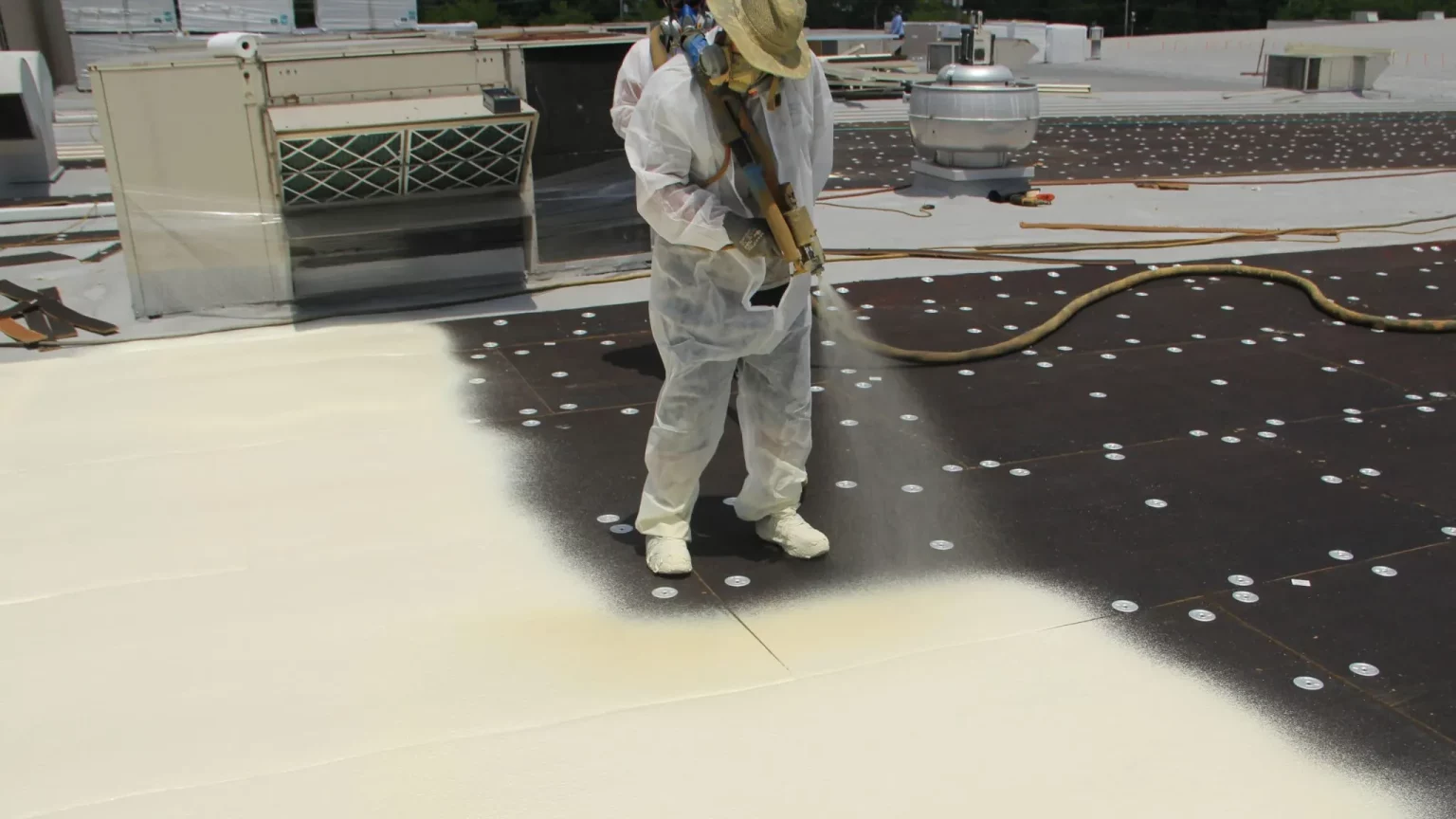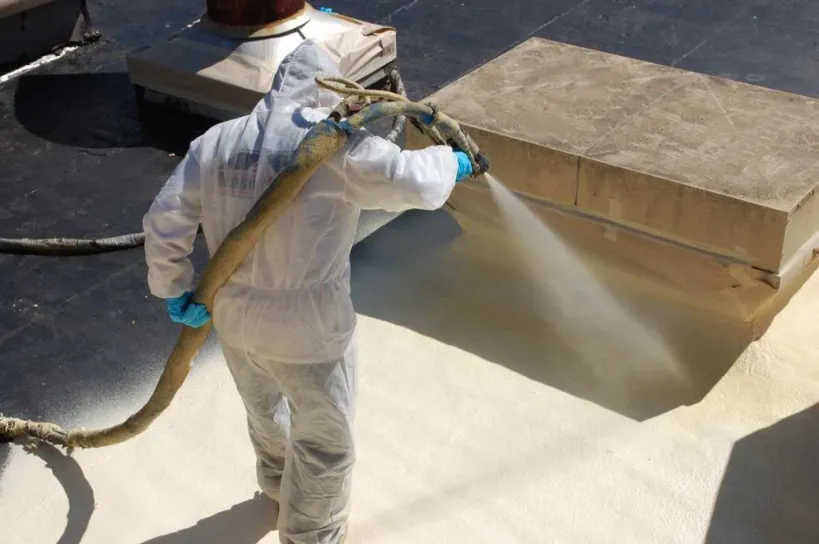Spray foam roofing provides a seamless, weather-resistant barrier that protects buildings from moisture, wind, and UV degradation. In Burien, WA—where rainfall, humidity, and seasonal changes can compromise conventional roofing materials—this system offers long-term durability, excellent insulation, and reduced maintenance.
This guide explains how spray foam roofing works, why it’s suited for Burien’s climate, and what to consider before installation. It includes technical comparisons, practical insights, and clear answers to common questions for informed decision-making.
Benefits of Spray Foam Roofing in Burien
Spray foam roofing creates a monolithic membrane that adheres directly to substrates such as metal, concrete, and existing roofs. Once cured, it forms a rigid, closed-cell structure that resists water infiltration, heat transfer, and structural degradation.
Key Advantages
- Seamless waterproofing across roof penetrations and joints
- High R-value for energy efficiency and thermal control
- Excellent adhesion to a variety of surfaces
- Lightweight application that adds minimal load
- Reflective topcoats for UV protection and lower cooling costs
This type of roofing solution significantly minimizes weak points found in other systems, such as seams, joints, and fasteners. That translates to fewer leak risks, especially in the Pacific Northwest’s wet environment. Additionally, the insulation value helps lower utility bills in both summer and winter.
Technical Specifications
| Feature | Spray Foam Roofing |
| Core Material | Closed-cell polyurethane foam |
| Typical Thickness | 1.5–3 inches |
| R-Value (per inch) | 6.5–7 |
| Weight | 1–1.5 lbs per square foot |
| Water Absorption | <1% |
| UV Protection | Topcoat (silicone or acrylic) required |
| Lifespan | 20–30 years with proper maintenance |
| Recoat Cycle | Every 10–15 years (depending on coating type) |
Properly applied spray foam achieves a dense, closed-cell finish that resists moisture intrusion while adding to the overall structural rigidity of the roof. In climates like Burien’s, these attributes are key to long-term performance.
Comparison with Traditional Roofing Systems
| Feature | Spray Foam Roofing | Built-Up Roofing (BUR) | Single-Ply Membranes |
| Seamless Application | Yes | No | No |
| Waterproof Performance | High | Moderate | Moderate |
| Energy Efficiency (R-value) | High | Low | Moderate |
| Installation Time | Fast | Slow | Moderate |
| Maintenance Requirements | Low | High | Moderate |
| Lifespan | 20–30 years | 15–20 years | 10–20 years |
| Suitable for Retrofitting | Yes | No | Yes |
Traditional roofing systems rely on multiple layers and seams, which can deteriorate faster under Burien’s frequent rain. Spray foam’s monolithic application significantly cuts down on leak-prone areas and results in fewer service calls over time.
Bonus Tip: Recoating the top layer every 10–15 years extends the roof’s lifespan significantly without requiring full replacement.
Spray Foam Roofing and Burien’s Climate
Burien’s maritime climate exposes roofs to frequent rain, seasonal temperature shifts, and UV stress during clear summers. Spray foam roofing is uniquely suited for this environment due to:
- Superior moisture resistance: Its closed-cell structure blocks water intrusion even during storms.
- Thermal regulation: High R-value supports year-round energy savings.
- UV and wind resistance: Protective coatings reduce thermal aging and surface cracking from sun and wind exposure.
Market Fact: According to IBISWorld’s roofing industry data, demand for energy-efficient roofing solutions in the Pacific Northwest has grown by over 7% annually due to local green building incentives and rising energy costs.
Spray foam roofing not only meets energy efficiency goals but also aligns with local sustainability mandates. Many building owners are switching to this system to qualify for LEED points and tax rebates.
Application Process Step by Step
1. Preparation and Inspection
Contractors clean and inspect the existing roof. Loose materials, water damage, or mold are removed or repaired.
2. Foam Application
Technicians spray two chemical components (isocyanate and polyol resin) that expand into dense foam, bonding to the substrate.
3. Curing and Trimming
The foam cures in minutes. Any uneven areas are trimmed to ensure drainage and smooth transitions around fixtures.
4. Protective Coating
A UV-resistant topcoat (silicone or acrylic) is applied to prevent sun damage and increase longevity.
Bonus Tip: Choose silicone coatings in high-precipitation areas like Burien—they offer better resistance to ponding water than acrylic options.
Each step is performed by trained professionals using specialized equipment. Weather and surface conditions must be optimal to ensure proper adhesion and curing.
Things to Consider Before Making a Decision
Roof Condition
Spray foam adheres best to structurally sound surfaces. Severely degraded roofs may require repairs before application.
Building Use and Load Requirements
Although lightweight, the addition of foam may affect existing load calculations. Confirm compatibility with structural engineers for sensitive builds.
Access and Overspray Control
During application, adjacent areas and HVAC intakes must be sealed or isolated to prevent airborne chemical contamination.
Long-Term Maintenance Plan
Recoat schedules, periodic inspections, and minor repairs are needed to maintain warranty compliance and optimal performance.
Common Questions About Spray Foam Roofing in Burien
Can spray foam be applied in wet or cold conditions?
No. It requires dry surfaces and specific temperature ranges (typically above 50°F) to adhere and cure properly.
Is it suitable for residential homes?
Yes, especially flat or low-slope residential roofs. The material provides added insulation and moisture protection.
Does it emit fumes during installation?
Yes, during spraying. Proper ventilation and temporary evacuation of the area are essential until curing is complete.
Can it be walked on?
Yes, after curing. However, high foot traffic areas may require walk pads to prevent compression damage.
Bonus Tip: Schedule spray foam roofing during dry months in Burien (typically June through September) for optimal results and shorter curing times.
Protect Your Building with the Durability of Spray Foam Roofing in Burien FAQ
How long does spray foam roofing last in Burien?
With routine maintenance and recoating, spray foam roofing can last 20–30 years even under Burien’s rainy conditions.
What types of buildings benefit most?
Commercial facilities, warehouses, schools, and low-slope homes often benefit most due to energy savings and seamless waterproofing.
Can it be installed over existing roofing?
Yes, if the existing surface is dry, clean, and in good condition. It reduces tear-off costs and landfill waste.
What kind of maintenance is required?
Routine inspections, recoating every 10–15 years, and quick sealing of any punctures or wear to maintain waterproof integrity.
Is it environmentally friendly?
Cascadia Spray foam reduces energy consumption due to its insulation properties, but some formulations may include chemicals. Look for low-VOC and EPA-compliant options.
Additional eco-friendly advantages include lower tear-off waste, reduced need for replacement, and potential integration with cool roof systems for reflective benefits.
Make the Right Decision
Spray foam roofing offers Burien property owners a reliable way to protect structures from harsh weather, moisture, and temperature swings. Its seamless application, insulating performance, and long-term durability make it a practical choice for many roof types. Evaluate your building’s structural needs, roofing history, and budget before making a decision. Consult a certified roofing contractor to assess your specific site conditions and get recommendations tailored to your property.
Reviewer: Olivia Thompson has spent 10 years working in spray foam insulation, helping companies grow their visibility. She reviewed this article and provided valuable suggestions on how to better align the content with the needs and expectations of customers, ensuring it resonates with the target audience.





